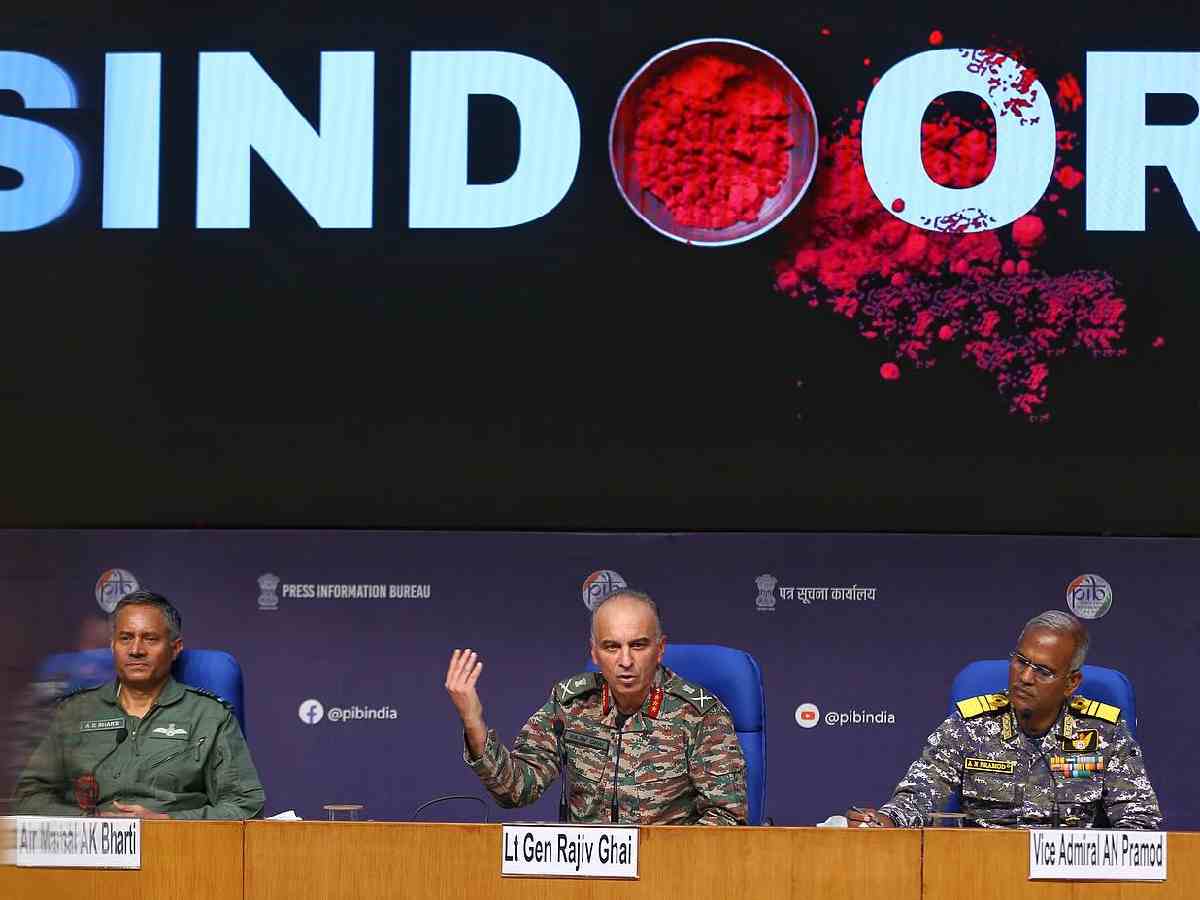India: Amid growing speculation, the Indian Air Force on Monday categorically denied reports of targeting nuclear installations in Pakistan’s Kirana Hills during its recent precision strikes.
Addressing the media, Air Marshal AK Bharti, Director General, Air Operations, dismissed the claims. “Thank you for telling us that Kirana Hills houses some nuclear installation, we did not know about it. We have not hit Kirana Hills, whatever is there,” he said.
The remark came as the Armed Forces in India held a press briefing on recent joint operations aimed at dismantling terror infrastructure in Pakistan-occupied Jammu and Kashmir (PoJK) and parts of Pakistan itself.
“Yesterday, we had a detailed brief on the successful joint operations that were carried out to destroy the terror infrastructure in Pakistan-occupied Jammu and Kashmir as well as in Pakistan itself,” said Air Marshal Bharti. “We also iterated that our fight was with terrorists and their support infrastructure and not with the Pakistan military.”
However, he criticised the Pakistan military’s involvement. “It is a pity that the Pakistan military chose to intervene and bat for the terrorists, which compelled us to respond in kind and made this fight their own,” he added. “In this situation, our response was very important and they are responsible for any loss they incurred.”
Air defence systems: Vintage and modern
Highlighting India’s air defence preparedness, Bharti underscored the Indian Armed Forces’ formidable, layered, and integrated air defence (AD) systems. These incorporate assets from the Army, Navy, and Air Force. The network includes a wide array of sensors, point-defence weapons like low-level air defence guns, man-portable air defence systems (MANPADS), short-range surface-to-air missiles (SAMs), and long-range air defence fighters.
“Numerous waves of drones and unmanned combat aerial vehicles employed by Pakistan were thwarted by the indigenously developed soft and hard kill counter-UAS systems and the well-trained Indian air defence personnel,” he noted.
Bharti said older systems like the Pechora, HOSA-AK, and LLAD guns had also played a critical role. These vintage systems, he explained, stood the test of time alongside modern indigenous platforms like the AKASH missile system.
Also Read: Operation Sindoor | Executed assigned tasks with precision: IAF
He credited the success of India’s air defence capabilities to a decade of sustained government support. “Putting together an operationalisation of this potent AD environment has been possible over the last decade due to unwavering support,” he said.
Debris displayed as proof
To underscore the efficacy of India’s defences, the Air Marshal showcased visuals of intercepted enemy missiles, including the Chinese-origin PL-15 missile, long-range rockets, loiter munitions, and drones such as the Turkish-origin YIHA systems.
“All these have been brought down by our trained crew and air defence systems,” he said.
He also presented images of the Indian Air Force’s precision strikes on the Noor Khan and Raimiyar Khan air bases. The visuals displayed massive craters and disabled runways, demonstrating the scale of damage inflicted.
Operation Sindoor: A unified tri-services response
Providing a strategic perspective, Lieutenant General Rajiv Ghai, Director General, Military Operations, elaborated on Operation Sindoor, underscoring the changing character of terrorist threats targeting not just the military but innocent civilians.
“In the last few years, the character of terrorist activities has been changing. In 2024, pilgrims to the Shiv Khori Temple in Jammu and, this year, innocent travellers in Pahalgam were attacked. By the time of Pahalgam, this pot of sin had been filled,” he said.
Lieutenant General Ghai lauded India’s multi-layered air defence system and said Pakistan stood no chance of breaching it. “In our inventory, we have a unique mixture of Counter-Unmanned Aerial System, Air Defence Weapons and mediums of electronic warfare, and that is why you saw when Pakistan air force attacked our airfield and logistic installation on May 9 and 10, they failed to breach this strong air defence grid,” he said.
He elaborated on the different levels of India’s defence setup. “You can see how many layers, counters, unmanned aerial systems, behind that shoulder-fired weapons and our vintage air defence weapons and in the last our modern air defence weapons system. There was no chance that Pakistan could’ve broken our multi-layered defence system and target our airfield and logistic installation.”
Drawing a colourful analogy with cricket legends, Ghai added, “Targeting our airfields and logistics is way too tough… I saw that Virat Kohli has just retired from test cricket; he is one of my favourites. In the 1970s, during the Ashes between Australia and England, two Australian bowlers destroyed the batting lineup of England, and then Australia gave a proverb—‘Ashes to ashes, dust to dust, if Thommo don’t get ya, Lillee must’. If you see the layers, you’ll understand what I am trying to say. Even if you crossed all the layers, one of the layers of this grid system will hit you.”
He also praised the Border Security Force for their contribution in repelling the Pakistani attack. “I want to praise BSF here also. Every last soldier gave their contribution to our mission. Their counter-unarmed system were also part of our multi-tiered grid system. You must have heard this proverb, ‘Jab hausle buland ho tab manzile bhi kadam chumti hai’. In the end, I’d like to highlight again that in every single domain.”
Navy asserts maritime dominance
Vice Admiral AN Pramod, Director General, Naval Operations, highlighted the Indian Navy’s role in bottling up Pakistani air assets near the Makran coast.
“Our powerful carrier battle group maintained an uncontested presence, compelling Pakistani air elements to remain close to their coast,” he stated.
He said the Navy’s fleet air defence mechanism, integrating multiple sensors and platforms, had neutralised aerial threats and ensured maritime superiority. “Should we choose to, we can strike at will,” he added.
On Pakistan’s denial and misinformation
When asked about Pakistan’s denial of losses and its misinformation campaign, Bharti responded, “Our fight is with terrorists, not with Pakistan military or civilians. The lack of credible information from their side is expected as they try to minimise the damage perception domestically.”
He also addressed confusion over terrorist leadership identities. Bharti claimed Pakistan was attempting to conflate Jaish-e-Mohammed’s Rauf Azgar with a Lashkar-e-Toiba operative, asserting that India’s targeting had been precise and based on credible intelligence.
Clarifying an earlier error, he corrected the origin of the YIHA drones. “Whether Turkish or any other, our indigenous counter-UAS systems have proven their worth. You have seen what we have done to them,” he said.
Full readiness for future challenges
Concluding the briefing, Bharti reiterated that all Indian military bases, equipment, and systems remained fully operational and prepared.
“This was a different kind of warfare and is bound to evolve. We need to stay ahead of the curve to beat the adversary,” he said.





